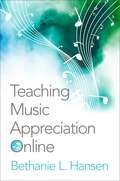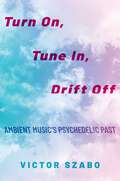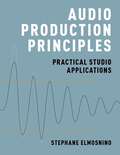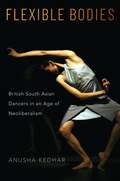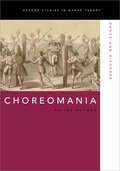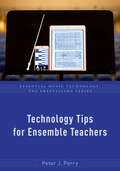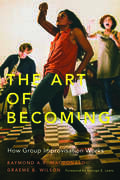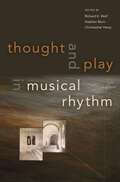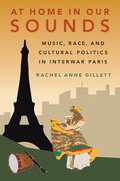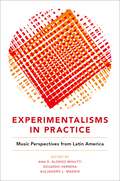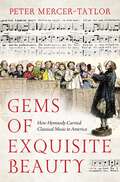- Table View
- List View
Eduard Hanslick's On the Musically Beautiful: A New Translation
by Lee Rothfarb Christoph LandererEduard Hanslick's On the Musically Beautiful (Vom Musikalisch-Schönen, 1854), written and published before the author turned 30, is a watershed document in the history of aesthetics, and of thought about music generally. The notion of "absolute music," which lies at the heart of the treatise, is now more than ever at the center of discussions about music, particularly that of the Classic and Romantic eras. Rothfarb and Landerer's translation includes three introductory essays offering fresh perspectives on Hanslick, and on the origins, publications, and translation history of his treatise, as well as its central concepts and philosophical underpinnings. The volume also includes thorough annotations, a readers' guide, a glossary of important terms and concepts, and an appendix, which comprises the original opening of Chapter 1, substantially rewritten in subsequent editions, as well as the original ending of the treatise that was excised by Hanslick in later editions. The book's ideas, cogently and often wittily expressed, are mandatory reading for anyone interested in eighteenth and nineteenth-century music and its cultural and intellectual background.
Teaching Music Appreciation Online
by Bethanie L. HansenIn this book, readers will learn practical tips and strategies to teach music appreciation online. As online education is a growing field, an increasing number of teachers trained in traditional/live methods find themselves now teaching online and potentially without mentors to assist them. Students are also changing, seeking highly engaged, relevant, and interactive learning opportunities that connect to their lives. Here, readers will find helpful guidance in planning curriculum, integrating multimedia assets, designing forum discussions, developing assignments, preparing rubrics, engaging in forum discussions, preparing, managing, and teaching, the course, providing feedback and grading, and following up with struggling and challenging students. The book can serve as a resource to those already teaching music appreciation online or as a comprehensive guide to those new to the field. Additionally, it may serve as a resource to instructors in other disciplines who seek to shift live-courses to the online format, as well as music appreciation instructors who would like to integrate digital or online components into traditional face-to-face courses. The book is organized into five major sections, designed to guide the novice online educator in depth while also appealing to the seasoned veteran through the ability to review each section as a stand-alone resource. Although some readers will desire to read from cover to cover, they will also be able to move in a non-linear manner from chapter to chapter, using chapters in modular form, in order to benefit from the sections that most apply to them at any given time.
TEACHING MUSIC APPRECIATION ONLINE 2E C
by Bethanie L. HansenIn this book, readers will learn practical tips and strategies to teach music appreciation online. As online education is a growing field, an increasing number of teachers trained in traditional/live methods find themselves now teaching online and potentially without mentors to assist them. Students are also changing, seeking highly engaged, relevant, and interactive learning opportunities that connect to their lives. Here, readers will find helpful guidance in planning curriculum, integrating multimedia assets, designing forum discussions, developing assignments, preparing rubrics, engaging in forum discussions, preparing, managing, and teaching, the course, providing feedback and grading, and following up with struggling and challenging students. The book can serve as a resource to those already teaching music appreciation online or as a comprehensive guide to those new to the field. Additionally, it may serve as a resource to instructors in other disciplines who seek to shift live-courses to the online format, as well as music appreciation instructors who would like to integrate digital or online components into traditional face-to-face courses. The book is organized into five major sections, designed to guide the novice online educator in depth while also appealing to the seasoned veteran through the ability to review each section as a stand-alone resource. Although some readers will desire to read from cover to cover, they will also be able to move in a non-linear manner from chapter to chapter, using chapters in modular form, in order to benefit from the sections that most apply to them at any given time.
Do You Remember House?: Chicago's Queer of Color Undergrounds
by Micah SalkindToday, no matter where you are in the world, you can turn on a radio and hear the echoes and influences of Chicago house music. Do You Remember House? tells a comprehensive story of the emergence, and contemporary memorialization of house in Chicago, tracing the development of Chicago house music culture from its beginnings in the late '70s to the present. Based on expansive research in archives and his extensive conversations with the makers of house in Chicago's parks, clubs, museums, and dance studios, author Micah Salkind argues that the remediation and adaptation of house music by crossover communities in its first decade shaped the ways that Chicago producers, DJs, dancers, and promoters today re-remember and mobilize the genre as an archive of collectivity and congregation. The book's engagement with musical, kinesthetic, and visual aspects of house music culture builds from a tradition of queer of color critique. As such, Do You Remember House? considers house music's liberatory potential in terms of its genre-defiant repertoire in motion. Ultimately, the book argues that even as house music culture has been appropriated and exploited, the music's porosity and flexibility have allowed it to remain what pioneering Chicago DJ Craig Cannon calls a "musical Stonewall" for queers and people of color in the Windy City and around the world.
DO YOU REMEMBER HOUSE? C: Chicago's Queer of Color Undergrounds
by Micah SalkindToday, no matter where you are in the world, you can turn on a radio and hear the echoes and influences of Chicago house music. Do You Remember House? tells a comprehensive story of the emergence, and contemporary memorialization of house in Chicago, tracing the development of Chicago house music culture from its beginnings in the late '70s to the present. Based on expansive research in archives and his extensive conversations with the makers of house in Chicago's parks, clubs, museums, and dance studios, author Micah Salkind argues that the remediation and adaptation of house music by crossover communities in its first decade shaped the ways that Chicago producers, DJs, dancers, and promoters today re-remember and mobilize the genre as an archive of collectivity and congregation. The book's engagement with musical, kinesthetic, and visual aspects of house music culture builds from a tradition of queer of color critique. As such, Do You Remember House? considers house music's liberatory potential in terms of its genre-defiant repertoire in motion. Ultimately, the book argues that even as house music culture has been appropriated and exploited, the music's porosity and flexibility have allowed it to remain what pioneering Chicago DJ Craig Cannon calls a "musical Stonewall" for queers and people of color in the Windy City and around the world.
Turn On, Tune In, Drift Off: Ambient Music's Psychedelic Past
by Victor SzaboTurn On, Tune In, Drift Off: Ambient Music's Psychedelic Past rethinks the history and socioaesthetics of ambient music as a popular genre with roots in the psychedelic countercultures of the late twentieth century. Victor Szabo reveals how anglophone audio producers and DJs between the mid-1960s and century's end commodified drone- and loop-based records as "ambient audio": slow, spare, spacious audio sold as artful personal media for creating atmosphere, fostering contemplation, transforming awareness, and stilling the body. The book takes a trip through landmark ambient audio productions and related discourses, including marketing rhetoric, artist manifestos and interviews, and music criticism, that during this time plotted the conventions of what became known as ambient music. These productions include nature sounds records, experimental avant-garde pieces, "space music" radio, psychedelic and cosmic rock albums, electronic dance music compilations, and of course, explicitly "ambient" music, all of which popularized ambient audio through vivid atmospheric concepts. In paying special attention to the sound of ambient audio; to ambient audio's relationship with the psychedelic, New Age, and rave countercultures of the US and UK; and to the coincident evolution of therapeutic audio and "head music" across alternative media and independent music markets, this history resituates ambient music as a hip highbrow framing and stylization of ongoing practices in crafting audio to alter consciousness, comportment, and mood. In so doing, Turn On, Tune In, Drift Off illuminates the social and aesthetic rifts and alliances informing one of today's most popular musical experimentalisms.
Turn On, Tune In, Drift Off: Ambient Music's Psychedelic Past
by Victor SzaboTurn On, Tune In, Drift Off: Ambient Music's Psychedelic Past rethinks the history and socioaesthetics of ambient music as a popular genre with roots in the psychedelic countercultures of the late twentieth century. Victor Szabo reveals how anglophone audio producers and DJs between the mid-1960s and century's end commodified drone- and loop-based records as "ambient audio": slow, spare, spacious audio sold as artful personal media for creating atmosphere, fostering contemplation, transforming awareness, and stilling the body. The book takes a trip through landmark ambient audio productions and related discourses, including marketing rhetoric, artist manifestos and interviews, and music criticism, that during this time plotted the conventions of what became known as ambient music. These productions include nature sounds records, experimental avant-garde pieces, "space music" radio, psychedelic and cosmic rock albums, electronic dance music compilations, and of course, explicitly "ambient" music, all of which popularized ambient audio through vivid atmospheric concepts. In paying special attention to the sound of ambient audio; to ambient audio's relationship with the psychedelic, New Age, and rave countercultures of the US and UK; and to the coincident evolution of therapeutic audio and "head music" across alternative media and independent music markets, this history resituates ambient music as a hip highbrow framing and stylization of ongoing practices in crafting audio to alter consciousness, comportment, and mood. In so doing, Turn On, Tune In, Drift Off illuminates the social and aesthetic rifts and alliances informing one of today's most popular musical experimentalisms.
Audio Production Principles: Practical Studio Applications
by Stephane ElmosninoWith this all-in-one manual, students and teachers have an easy-to-read reference that provides a reliable and current rundown of the world of sound production, from planning a recording session to mastering the final product. Organized by four main topics - pre-production, recording various instruments, mixing theories and tools, and mastering - Audio Production Principles follows the actual flow of instruction given over the course of a student's tenure. Chapters address etiquette and basic operations for any recording session written in useful, tutorial style language, providing guidelines for beginner audio engineers on topics including pre-production, equipment selection, and mixing tips by instrument. Jumpstarting the mastering process, lessons delve into features unique to specific tools and techniques. All sections offer instructional scenarios of studio setups, asking students to brainstorm the best production technique for each situation. These exercises also help teachers generate new ideas for instruction and production projects of their own.
AUDIO PRODUCTION PRINCIPLES C: Practical Studio Applications
by Stephane ElmosninoWith this all-in-one manual, students and teachers have an easy-to-read reference that provides a reliable and current rundown of the world of sound production, from planning a recording session to mastering the final product. Organized by four main topics - pre-production, recording various instruments, mixing theories and tools, and mastering - Audio Production Principles follows the actual flow of instruction given over the course of a student's tenure. Chapters address etiquette and basic operations for any recording session written in useful, tutorial style language, providing guidelines for beginner audio engineers on topics including pre-production, equipment selection, and mixing tips by instrument. Jumpstarting the mastering process, lessons delve into features unique to specific tools and techniques. All sections offer instructional scenarios of studio setups, asking students to brainstorm the best production technique for each situation. These exercises also help teachers generate new ideas for instruction and production projects of their own.
UNFINISHED BUSINESS C: Michael Jackson, Detroit, and the Figural Economy of American Deindustrialization
by Judith HameraHow does structural economic change look and feel? How are such changes normalized? Who represents hope? Who are the cautionary tales? Unfinished Business argues that U.S. deindustrialization cannot be understood apart from issues of race, and specifically apart from images of, and works by and about African Americans that represent or resist normative or aberrant relationships to work and capital in transitional times. It insists that Michael Jackson's performances and coverage of his life, plays featuring Detroit, plans for the city's postindustrial revitalization, and Detroit installations The Heidelberg Project and Mobile Homestead have something valuable to teach us about three decades of structural economic transition in the U.S., particularly about the changing nature of work and capitalism between the mid 1980s and 2016. Jackson and Detroit offer examples of the racialization of deindustrialization, how it operates as a structure of feeling and as representations as well as a shift in the dominant mode of production, and how industrialization's successor mode, financialization, uses imagery both very similar to and very different from its predecessor.
Flexible Bodies: British South Asian Dancers in an Age of Neoliberalism
by Anusha KedharFlexible Bodies honors the lives and labor of British South Asian dancers and celebrates their contributions to a distinct and dynamic sector of British dance. Drawing on expertise gained from over seven years dancing in Britain, author Anusha Kedhar presents a multifaceted picture of British South Asian dance as its own distinctive genre.ÂAnalyzing dance works, dance films, rehearsals, and touring - alongside immigration policy, arts funding initiatives, and global economic conditions - Flexible Bodies traces shifts in British South Asian dance from 1990s "Cool Britannia" multiculturalism to fallout from the 2008 global financial crisis and, more recently, the anti-immigration rhetoric leading up to the Brexit referendum in 2016. Kedhar draws on over a decade of interviews and conversations with dancers in Britain as well as in-depth choreographic analysis of major dance works to reveal the creative ways in which British South Asian dancers negotiate neoliberal, multicultural dance markets through an array of flexible bodily practices. Providing a new, critical dance studies lens through which to view the precarious economic, racial, national, and legal positions of South Asians in Britain, Flexible BodiesÂultimately argues for centering dance labor in studies of neoliberalism.
Flexible Bodies: British South Asian Dancers in an Age of Neoliberalism
by Anusha KedharFlexible Bodies honors the lives and labor of British South Asian dancers and celebrates their contributions to a distinct and dynamic sector of British dance. Drawing on expertise gained from over seven years dancing in Britain, author Anusha Kedhar presents a multifaceted picture of British South Asian dance as its own distinctive genre.ÂAnalyzing dance works, dance films, rehearsals, and touring - alongside immigration policy, arts funding initiatives, and global economic conditions - Flexible Bodies traces shifts in British South Asian dance from 1990s "Cool Britannia" multiculturalism to fallout from the 2008 global financial crisis and, more recently, the anti-immigration rhetoric leading up to the Brexit referendum in 2016. Kedhar draws on over a decade of interviews and conversations with dancers in Britain as well as in-depth choreographic analysis of major dance works to reveal the creative ways in which British South Asian dancers negotiate neoliberal, multicultural dance markets through an array of flexible bodily practices. Providing a new, critical dance studies lens through which to view the precarious economic, racial, national, and legal positions of South Asians in Britain, Flexible BodiesÂultimately argues for centering dance labor in studies of neoliberalism.
Choreomania: Dance and Disorder (Oxford Studies in Dance Theory)
by Kélina GotmanWhen political protest is read as epidemic madness, religious ecstasy as nervous disease, and angular dance moves as dark and uncouth, the 'disorder' being described is choreomania. At once a catchall term to denote spontaneous gestures and the unruly movements of crowds, 'choreomania' emerged in the nineteenth century at a time of heightened class conflict, nationalist policy, and colonial rule. In this book, author Kélina Gotman examines these choreographies of unrest, rethinking the modern formation of the choreomania concept as it moved across scientific and social scientific disciplines. Reading archives describing dramatic misformations-of bodies and body politics-she shows how prejudices against expressivity unravel, in turn revealing widespread anxieties about demonstrative agitation. This history of the fitful body complements stories of nineteenth-century discipline and regimentation. As she notes, constraints on movement imply constraints on political power and agency. In each chapter, Gotman confronts the many ways choreomania works as an extension of discourses shaping colonialist orientalism, which alternately depict riotous bodies as dangerously infected others, and as curious bacchanalian remains. Through her research, Gotman also shows how beneath the radar of this colonial discourse, men and women gathered together to repossess on their terms the gestures of social revolt.
CHOREOMANIA OSDT C: Dance and Disorder (Oxford Studies in Dance Theory)
by Kélina GotmanWhen political protest is read as epidemic madness, religious ecstasy as nervous disease, and angular dance moves as dark and uncouth, the 'disorder' being described is choreomania. At once a catchall term to denote spontaneous gestures and the unruly movements of crowds, 'choreomania' emerged in the nineteenth century at a time of heightened class conflict, nationalist policy, and colonial rule. In this book, author Kélina Gotman examines these choreographies of unrest, rethinking the modern formation of the choreomania concept as it moved across scientific and social scientific disciplines. Reading archives describing dramatic misformations-of bodies and body politics-she shows how prejudices against expressivity unravel, in turn revealing widespread anxieties about demonstrative agitation. This history of the fitful body complements stories of nineteenth-century discipline and regimentation. As she notes, constraints on movement imply constraints on political power and agency. In each chapter, Gotman confronts the many ways choreomania works as an extension of discourses shaping colonialist orientalism, which alternately depict riotous bodies as dangerously infected others, and as curious bacchanalian remains. Through her research, Gotman also shows how beneath the radar of this colonial discourse, men and women gathered together to repossess on their terms the gestures of social revolt.
Technology Tips for Ensemble Teachers (Essential Music Technology:The Prestissimo Series)
by Peter J. PerryWritten by veteran music educator Peter J. Perry, Technology Tips for Ensemble Teachers presents a collection of practical tips to help today's school music ensemble director incorporate and implement technology in all aspects of large ensemble instruction. This go-to guide offers specific methods for the use of technology in ensemble instruction, identifies applicable technologies, and details proven ways to successfully use those technologies in instruction. Tips throughout the book vary in type and complexity, allowing directors of all technical abilities to use the book effectively to meet the unique needs of their ensembles and students. They also offer content-specific examples for technologies in band, orchestra, jazz ensemble, and chorus instruction, as well as emerging ensemble settings such as percussion ensembles, guitar ensembles, rock bands, a capella groups, and iPad ensembles. With a special focus on current technologies including mobile devices, Technology Tips for Ensemble Teachers is a timely and useful resource for directors as students and classrooms become ever more technology-oriented.
TECH TIPS FOR ENSEMBLE TEACHERS EMT C (Essential Music Technology:The Prestissimo Series)
by Peter J. PerryWritten by veteran music educator Peter J. Perry, Technology Tips for Ensemble Teachers presents a collection of practical tips to help today's school music ensemble director incorporate and implement technology in all aspects of large ensemble instruction. This go-to guide offers specific methods for the use of technology in ensemble instruction, identifies applicable technologies, and details proven ways to successfully use those technologies in instruction. Tips throughout the book vary in type and complexity, allowing directors of all technical abilities to use the book effectively to meet the unique needs of their ensembles and students. They also offer content-specific examples for technologies in band, orchestra, jazz ensemble, and chorus instruction, as well as emerging ensemble settings such as percussion ensembles, guitar ensembles, rock bands, a capella groups, and iPad ensembles. With a special focus on current technologies including mobile devices, Technology Tips for Ensemble Teachers is a timely and useful resource for directors as students and classrooms become ever more technology-oriented.
The Art of Becoming: How Group Improvisation Works
by Raymond A. MacDonald Graeme B. WilsonAt a time of unprecedented interest in improvisation across the arts, The Art of Becoming boldly asserts that everyone can and should improvise. Drawing on emerging psychological literature as well as their own research with musicians, authors Raymond MacDonald and Graeme Wilson - both music psychologists and renowned performers in their own right - propose new ideas on what defines improvisation in music. MacDonald and Wilson explore the cognitive processes involved, the role of specialist skills or knowledge in improvised interaction, and the nature of understanding between improvisers. Their investigation lays out how we develop as improvisers, alongside health benefits derived from music participation. The Art of Becoming is a vital resource for courses on improvisation in contemporary practice, and for those applying musical improvisation in community and therapeutic contexts, setting out a framework based on psychological findings for understanding improvisation as a universal capability and an essentially social behavior. With suggestions for approaching this practice in new ways at any level, it demonstrates how improvisation transcends musical genres and facilitates collaboration between practitioners from disciplines across the artistic spectrum. Putting forward important implications for contemporary artistic practices, pedagogy, music therapy and the psychology of social behavior, The Art of Becoming provides fresh and provocative insights for anyone interested in playing, studying, teaching, or listening to improvised music.
ART OF BECOMING C: How Group Improvisation Works
by Raymond A. MacDonald Graeme B. WilsonAt a time of unprecedented interest in improvisation across the arts, The Art of Becoming boldly asserts that everyone can and should improvise. Drawing on emerging psychological literature as well as their own research with musicians, authors Raymond MacDonald and Graeme Wilson - both music psychologists and renowned performers in their own right - propose new ideas on what defines improvisation in music. MacDonald and Wilson explore the cognitive processes involved, the role of specialist skills or knowledge in improvised interaction, and the nature of understanding between improvisers. Their investigation lays out how we develop as improvisers, alongside health benefits derived from music participation. The Art of Becoming is a vital resource for courses on improvisation in contemporary practice, and for those applying musical improvisation in community and therapeutic contexts, setting out a framework based on psychological findings for understanding improvisation as a universal capability and an essentially social behavior. With suggestions for approaching this practice in new ways at any level, it demonstrates how improvisation transcends musical genres and facilitates collaboration between practitioners from disciplines across the artistic spectrum. Putting forward important implications for contemporary artistic practices, pedagogy, music therapy and the psychology of social behavior, The Art of Becoming provides fresh and provocative insights for anyone interested in playing, studying, teaching, or listening to improvised music.
Thought and Play in Musical Rhythm
Thought and Play in Musical Rhythm offers new understandings of musical rhythm through the analysis and comparison of diverse repertoires, performance practices, and theories as formulated and transmitted in speech or writing. Editors Richard K. Wolf, Stephen Blum, and Christopher Hasty address a productive tension in musical studies between universalistic and culturally relevant approaches to the study of rhythm. Reacting to commonplace ideas in (Western) music pedagogy, the essays explore a range of perspectives on rhythm: its status as an "element" of music that can be usefully abstracted from timbre, tone, and harmony; its connotations of regularity (or, by contrast, that rhythm is what we hear against the grain of background regularity); and its special embodiment in percussion parts. Unique among studies of musical rhythm, the collection directs close attention to ways performers and listeners conceptualize aspects of rhythm and questions many received categories for describing rhythm. By drawing the ear and the mind to tensions, distinctions, and aesthetic principles that might otherwise be overlooked, this focus on local concepts enables the listener to dispel assumptions about how music works "in general." Readers may walk away with a few surprises, become more aware of their assumptions, and/or think of new ways to shock their students out of complacency.
THOUGHT & PLAY IN MUSICAL RHYTHM C
by Richard K. Wolf, Stephen Blum, and Christopher HastyThought and Play in Musical Rhythm offers new understandings of musical rhythm through the analysis and comparison of diverse repertoires, performance practices, and theories as formulated and transmitted in speech or writing. Editors Richard K. Wolf, Stephen Blum, and Christopher Hasty address a productive tension in musical studies between universalistic and culturally relevant approaches to the study of rhythm. Reacting to commonplace ideas in (Western) music pedagogy, the essays explore a range of perspectives on rhythm: its status as an "element" of music that can be usefully abstracted from timbre, tone, and harmony; its connotations of regularity (or, by contrast, that rhythm is what we hear against the grain of background regularity); and its special embodiment in percussion parts. Unique among studies of musical rhythm, the collection directs close attention to ways performers and listeners conceptualize aspects of rhythm and questions many received categories for describing rhythm. By drawing the ear and the mind to tensions, distinctions, and aesthetic principles that might otherwise be overlooked, this focus on local concepts enables the listener to dispel assumptions about how music works "in general." Readers may walk away with a few surprises, become more aware of their assumptions, and/or think of new ways to shock their students out of complacency.
At Home in Our Sounds: Music, Race, and Cultural Politics in Interwar Paris
by Rachel Anne GillettAt Home in Our Sounds illustrates the effect jazz music had on the enormous social challenges Europe faced in the aftermath of World War I. Examining the ways African American, French Antillean, and French West African artists reacted to the heightened visibility of racial difference in Paris during this era, author Rachel Anne Gillett addresses fundamental cultural questions that continue to resonate today: Could one be both black and French? Was black solidarity more important than national and colonial identity? How could French culture include the experiences and contributions of Africans and Antilleans? Providing a well-rounded view of black reactions to jazz in interwar Paris, At Home in Our Sounds deals with artists from highly educated women like the Nardal sisters of Martinique, to the working black musicians performing at all hours throughout the city. In so doing, the book places this phenomenon in its historical and political context and shows how music and music-making constituted a vital terrain of cultural politics--one that brought people together around pianos and on the dancefloor, but that did not erase the political, regional, and national differences between them.
At Home in Our Sounds: Music, Race, and Cultural Politics in Interwar Paris
by Rachel Anne GillettAt Home in Our Sounds illustrates the effect jazz music had on the enormous social challenges Europe faced in the aftermath of World War I. Examining the ways African American, French Antillean, and French West African artists reacted to the heightened visibility of racial difference in Paris during this era, author Rachel Anne Gillett addresses fundamental cultural questions that continue to resonate today: Could one be both black and French? Was black solidarity more important than national and colonial identity? How could French culture include the experiences and contributions of Africans and Antilleans? Providing a well-rounded view of black reactions to jazz in interwar Paris, At Home in Our Sounds deals with artists from highly educated women like the Nardal sisters of Martinique, to the working black musicians performing at all hours throughout the city. In so doing, the book places this phenomenon in its historical and political context and shows how music and music-making constituted a vital terrain of cultural politics--one that brought people together around pianos and on the dancefloor, but that did not erase the political, regional, and national differences between them.
Experimentalisms in Practice: Music Perspectives from Latin America
Experimentalisms in Practice explores the multiple sites in which experimentalism emerges and becomes meaningful beyond Eurocentric interpretative frameworks. Challenging the notion of experimentalism as defined in conventional narratives, contributors take a broad approach to a wide variety of Latin@ and Latin American music traditions conceived or perceived as experimental. The conversation takes as starting point the 1960s, a decade that marks a crucial political and epistemological moment for Latin America; militant and committed aesthetic practices resonated with this moment, resulting in a multiplicity of artistic and musical experimental expressions. Experimentalisms in Practice responds to recent efforts to reframe and reconceptualize the study of experimental music in terms of epistemological perspective and geographic scope, while also engaging traditional scholarship. This book contributes to the current conversations about music experimentalism while providing new points of entry to further reevaluate the field.
EXPERIMENTALISMS IN PRACTICE C: Music Perspectives from Latin America
by Ana R. Alonso-Minutti, Eduardo Herrera and Alejandro L. MadridExperimentalisms in Practice explores the multiple sites in which experimentalism emerges and becomes meaningful beyond Eurocentric interpretative frameworks. Challenging the notion of experimentalism as defined in conventional narratives, contributors take a broad approach to a wide variety of Latin@ and Latin American music traditions conceived or perceived as experimental. The conversation takes as starting point the 1960s, a decade that marks a crucial political and epistemological moment for Latin America; militant and committed aesthetic practices resonated with this moment, resulting in a multiplicity of artistic and musical experimental expressions. Experimentalisms in Practice responds to recent efforts to reframe and reconceptualize the study of experimental music in terms of epistemological perspective and geographic scope, while also engaging traditional scholarship. This book contributes to the current conversations about music experimentalism while providing new points of entry to further reevaluate the field.
Gems of Exquisite Beauty: How Hymnody Carried Classical Music to America
by Peter Mercer-TaylorIn the decades leading up to the Civil War, most Americans probably encountered European classical music primarily through hymn tunes. Hymnody was the most popular and commercially successful genre of the antebellum period in the United States, and the unquenchable thirst for new tunes to sing led to a phenomenon largely forgotten today: in their search for fresh material, editors lifted hundreds of tunes from the works of major classical composers to use as settings of psalms and hymns. The few that remain popular today millions have sung "Joyful, Joyful We Adore Thee" to Beethoven and "Hark, The Herald Angels Sing" to Mendelssohn are vestiges of one of the most distinctive trends in antebellum music-making. Gems of Exquisite Beauty is the first in-depth study of the historical rise and fall of this adaptation practice, its artistic achievements, and its place in nineteenth-century American musical life. It traces the contributions of pioneering figures like Arthur Clifton and the impact of bestsellers like the Handel and Haydn Society Collection, which helped turn Lowell Mason into America's most influential musician. By telling the tales of these hymns and those who brought them into the world, author Peter Mercer-Taylor reveals a central part of the history of how the American public first came to meet and creatively engage with Europe's rich musical practices.

